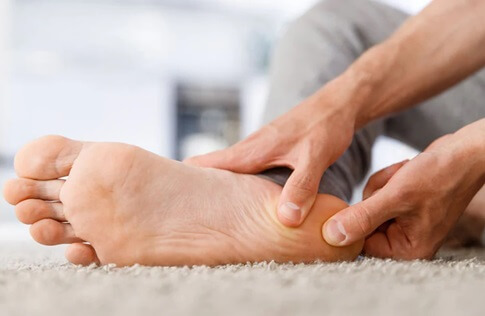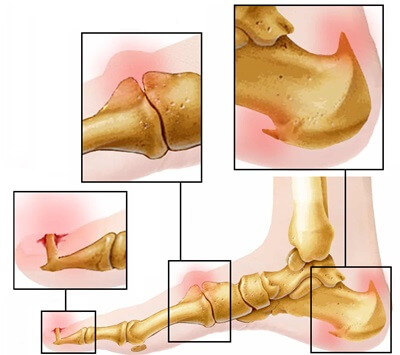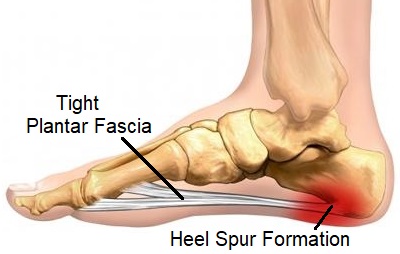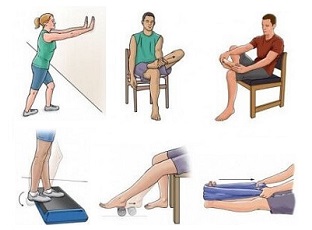- Home
- Common Foot Problems
- Foot Bone Spurs
Bone Spurs In Feet
Written By: Chloe Wilson BSc(Hons) Physiotherapy
Reviewed By: FPE Medical Review Board

Bone spurs in feet are a common and often painful condition that can limit mobility and affect your quality of life.
Also known as osteophytes, bone spurs develop as bony projections along the edges of bones.
They usually develop in response to irritation of the bone from inflammation, repetitive friction or stress, or following an injury. The body tries to protect itself by laying down new bone, but left unchecked, results in bone spur foot pain.
In this article, we’ll explore what bone spurs in the feet are, the types of spurs that affect the foot, their causes, symptoms, and treatment options.
What is a Foot Spur?

Foot bone spurs develop when abnormal excess bone growth causes a hard lump to form on the bone.
When there is regular irritation or friction on a bone, the body responds by stimulating cells to produce excess calcium deposits to try and protect the bone from injury.
As the calcium deposit layers build up, new bone is formed. This is very helpful initially as it helps to protect the bone and repair any damage, but if it continues, a bone spur forms.
Foot bone spurs themselves are not painful or dangerous but if they start encroaching on neighbouring structures like muscles, tendons, nerves or other bones, they can cause pain, stiffness and numbness.
What Causes Foot Bone Spurs?
Common causes of bone spurs in feet include:
- Repetitive Stress or Overuse: High-impact, repetitive activities e.g. running and jumping (particularly on hard surfaces), or prolonged walking/standing, can increase the likelihood of bone spur formation
- Tension: Tightness in soft tissues e.g. ligaments, muscles and tendons, is a common cause of bone spurs in feet. The tight tissue pulls on the part of the bone that it is attached too, causing excessive tension and local inflammation e.g. tight calf muscles/Achilles tendon leads to heel bone spurs
- Foot Structure & Biomechanics: Abnormal foot mechanics, flat feet, or high arches affects the position of the foot bones and how they move. This can put extra stress on certain areas, encouraging bone spur growth
- Trauma or Injury: anything from minor bruising to a fracture can lead to the laying down of excess calcium deposits as part of the normal healing process. This is a good response to the problem in the short term, ensuring the bone heels, but if it continues too long, bone spur foot pain may develop
- Arthritis: Osteoarthritis leads to cartilage breakdown, causing bones to rub against each other. This can prompt the formation of spurs as the body tries to repair the damage
- Inflammation: When a joint is inflamed due to chronic conditions such as rheumatoid arthritis or gout foot, the constant irritation can lead to bone spur foot pain
- Footwear: Wearing shoes that are too tight, unsupportive or the wrong shape place repetitive friction on parts of the foot. This commonly occurs on the back of heel or in the toes.
- Gender: Bone spurs in feet are more common in women than men up to the age of around 60. This is mostly due to footwear. Over the age of 60, foot bone spurs become more prevalent in men
- Aging: With age, joint cartilage thins and deteriorates, which can lead to increased bone-on-bone contact and spur formation as the body compensates for the loss of cushioning
- Charcot Foot: Charcot-Marie-Tooth disease is a condition which causes weakness and sensory changes in the foot due to nerve damage, is associated with increased risk of developing bone spurs in feet
Foot bones spurs are very common, affecting up to almost 40% of individuals at some point in their lives. However, they often go completely unnoticed unless they get to large enough to encroach on neighbouring structures or are just in the wrong place.
Types of Foot Bone Spur
Bone spurs in the feet can form in several areas, each with distinct characteristics and symptoms:
1. Heel Spurs
The most common place to develop bone spurs in feet is on the heel. Heel spurs are bony projections on either the back or the underside of the heel bone.

Inferior Calcaneal Spurs develop underneath the heel bone, usually in response to plantar fasciitis, a condition that causes inflammation of the thick band of tissue (plantar fascia) running along the bottom of the foot.
Typically, you can’t see or feel inferior heel spurs, as they are surrounded by soft tissue, until they are quite large.
Posterior Calcaneal Spurs aka Haglund’s Deformity, develop on the back of the heel, usually due to Achilles tendonitis, calf muscle tightness or ill-fitting shoes.
You can usually see and feel a lump on the back of your heel with posterior heel spurs - they are often quite prominent.
2. Tarsal Spurs
Tarsal spurs, aka tarsal boss, form in the midfoot region. They may develop on the top of the foot (dorsal spur) or the bottom of the midfoot (plantar spur). Tarsal spurs can make it difficult to wear shoes comfortably, as the bump may press against the shoe.
3. Toe Joint Spurs
Spurs can form around the joints of the toes, particularly the big toe, due to arthritis or repetitive stress. They may lead to joint stiffness, hallux rigidus, pain and limited movement.
Bone Spur Foot Symptoms
Not all foot bone spurs cause symptoms, but when they do, they can range from mild to severe. Common symptoms of bone spurs in feet include:
- Localized Pain: Pain can range from a dull ache to a sharp or stabbing pain, especially during walking, running, or standing
- Difficulty Walking/Standing: Bone spur foot pain tends to be worse after periods of rest, particularly first thing in the morning or after sitting for long periods. The first few steps are often extremely painful, but the pain starts to subside after a while as the soft tissues stretch out. It does however, often return if you are on your feet for long periods
- Bony Lumps: A hard foot bump may be felt or seen, especially in the case of dorsal spurs on the top of the foot, or spurs on the back of the heel
- Swelling and Inflammation: Spurs can irritate surrounding soft tissues, causing swelling, redness or inflammation, particularly in the heel or top of the foot
- Stiffness and Limited Motion: Spurs around the joints may cause stiffness or limit the range of motion. This is particularly common with big toe spurs and can lead to hallux rigidus
- Corns/Calluses: The foot may try to cushion the osteophyte from above, resulting in corns or callus formation on the overlying skin
- Sensory Changes: if bone spurs in feet start pressing on nearby nerves, it can cause foot bone spur symptoms such as tingling, numbness or weakness
#CommissionEarned from Amazon on qualifying purchases
Foot Spur Treatment Options
Bone spurs in feet are only treated if they are causing problems. If there is a noticeable lump, but no pain or other symptoms, they will usually be left alone. If however they start to cause symptoms such as pain or numbness, or they are causing damage to surrounding structures, treatment is required.
Foot spur treatment usually involves:
1. Rest and Activity Modification
Avoiding activities that aggravate the symptoms can help reduce inflammation and pain. High intensity, repetitive activities involving lots of running and jumping should be avoided where possible
2. Medication
Over-the-counter medications e.g. ibuprofen/Advil or naproxen can be useful to reduce pain and inflammation associated with foot bone spurs. While they won’t shrink the bone spurs, they will help reduce symptoms
3. Footwear Changes
Supportive, well-fitting shoes with good arch support, shock absorption, and a spacious toe box can reduce pressure on the spurs and surrounding tissues.
4. Orthotic Inserts
Custom orthotics or shoe inserts can help reduce pressure through the bone spur foot:
- Heel Cups/Pads: are particularly useful with heel bone spurs
- Full Length Orthotic Inserts: with arch support are helpful with all types of bone spur foot pain
- Toe Spreaders: are useful with toe spurs
5. Physical Therapy
Stretching and strengthening exercises can help improve foot flexibility, strength and stability, easing the discomfort from bone spurs in feet.
6. Cold Therapy
Applying an ice pack to the affected area on the foot for 10-15 minutes, every couple of hours can help reduce inflammation and numb the pain.
7. Corticosteroid Injections
For severe pain, a healthcare provider may recommend a corticosteroid injection to reduce inflammation around the spur. The effects usually last for around 3 months.
You can find out more in the heel bone spur treatment section.
Do foot spurs go away? These treatments will not shrink or get rid of bone spurs in feet, but they can help to reduce the symptoms. The only way to actually get rid of a bone spur is to have it surgically removed. 90% of people with foot bone spurs will recover within 6-9 months through a combination of exercises, activity modification, orthotics and medication. The remaining 10% may require surgical intervention.
Foot Spur Surgery
If conservative treatments don’t relieve symptoms, surgery may be considered. The type of surgery recommended will vary depending on the size and location of the foot bone spur:
- Bone Spur Resection: aka exosectomy, removes the bony calcium deposits to reduce pressure and inflammation. There are different types of spur resection surgery depending on the location. Dorsal Spur Excision removes osteophytes on the top of the foot. Cheilectomy removes big toe spurs. Inferior Heel Resection removes spurs underneath the heel. Posterior Heel Resection removes spurs from the back of the heel
- Soft Tissue Release: If tightness in the soft tissues is contributing to bone spur foot pain, then they may need to be released. For inferior heel spurs linked with plantar fasciitis, a plantar fascia release may be performed where small cuts are made in the plantar fascia. For posterior heel spurs, the heel bursa may be removed as well as part of the Achilles tendon.
- Joint Fusion: In cases where arthritis has severely affected the joint, a fusion procedure may be done to eliminate motion at the affected joint and reduce pain. Any damaged cartilage is removed from the joint to create a smooth surface and screws are inserted into the bones either side of the joint to hold them together while they naturally fuse
- Joint Replacement: If there is significant joint damage or osteoarthritis then the damaged part of the joint is removed and replaced with artificial components.
After foot bone spur surgery you should be able to walk straight away but you may need to use crutches and/or a special walking boot for a couple of weeks while the foot heals.
Recovery from foot spur surgery typically involves rest, physical therapy, and gradual return to weight-bearing activities. Full recovery may take several weeks, depending on the location and complexity of the procedure.
Bone Spurs In Feet Summary
Bone spurs in the feet are a common problem, affecting up to around 40% of the population at some point.
Repetitive pressure or friction causes the body to lay down calcium deposits in an attempt to protect the bone.
Often, foot bone spurs don’t cause any problems, but if they become large enough or start pressing on neighbouring structures they can result in pain.
Foot bone spurs can develop in different places, each with different symptoms:
- Heel Spurs: develop on the back or bottom of the heel bone aka calcaneal spurs
- Tarsal Spurs: develop in the mid-foot region
- Toe Spurs: develop on the toes, most commonly the big toe
In most cases, the symptoms of bone spurs in the feet can be treated with a combination of rest, strengthening and stretching exercises, ice, medication and orthotics. If symptoms fail to respond to treatment then foot spur surgery may be required. You can find out more in the heel spur treatment section.
You may also be interested in the following articles:
- Foot Lumps & Bumps
- Pain On Top Of Foot
- Common Causes Of Heel Pain
- Foot Pain When Walking
- Foot Tendonitis
Related Articles
References
- Changes In Prevalence Of Calcaneal Spurs In Men & Women: A Random Population From A Trauma Clinic. BMC Musculoskeletal Disorders
- Calcaneal Spurs: A Potentially Debilitating Disorder. National Library Of Medicine
- Effectiveness Of Mechanical Treatment With Customized Insole And Minimalist Flexible Footwear For Women With Calcaneal Spur: Randomized Controlled Trial. BMC Muscuolskeletal Disorders
Page Last Updated: 19th November, 2024
Next Review Due: 19th November, 2026






